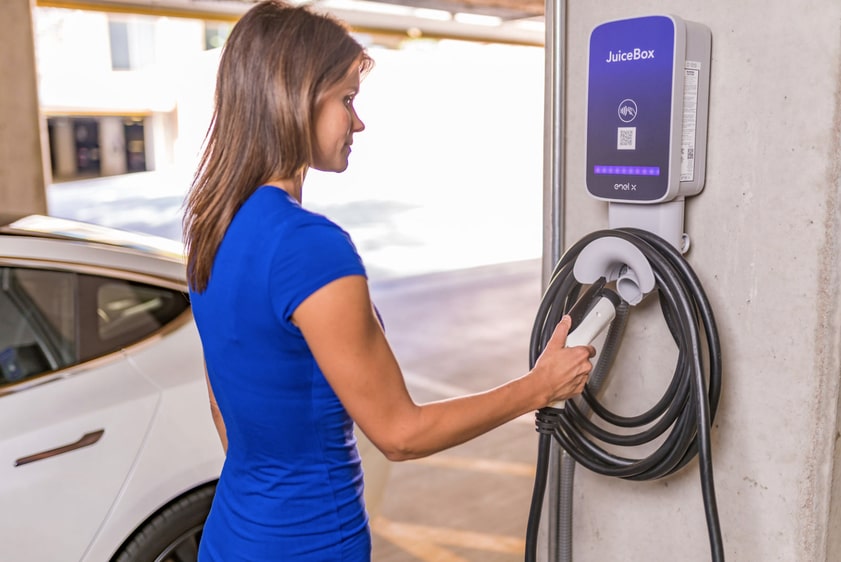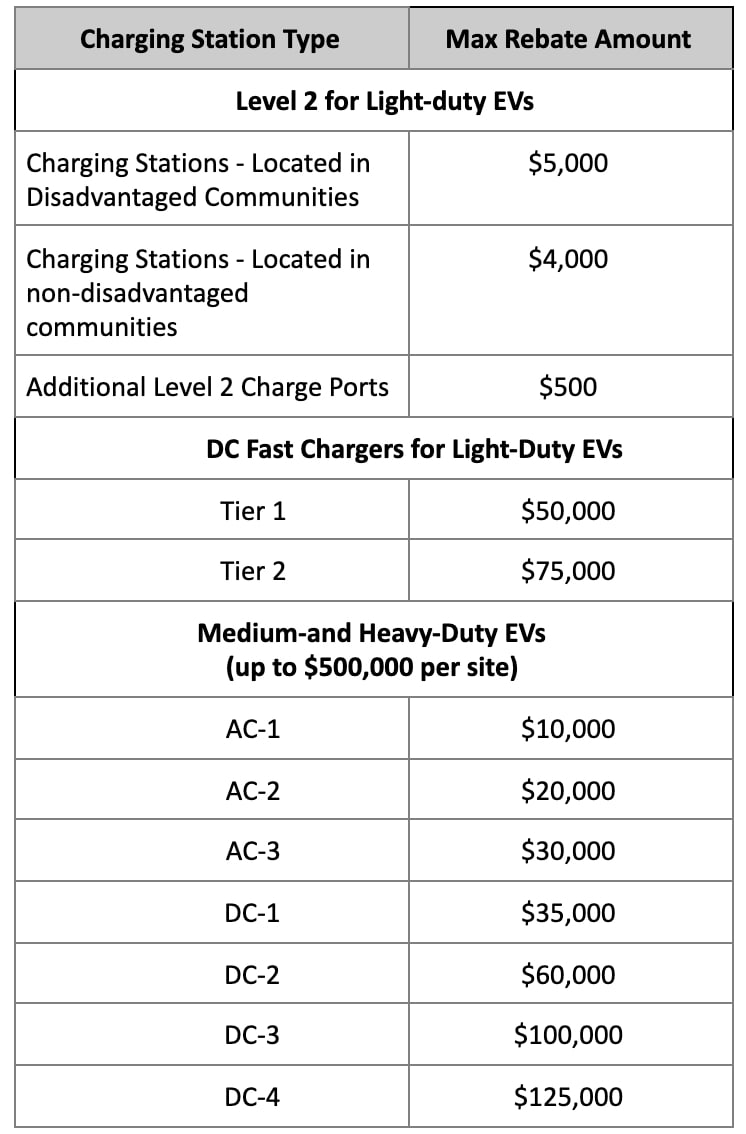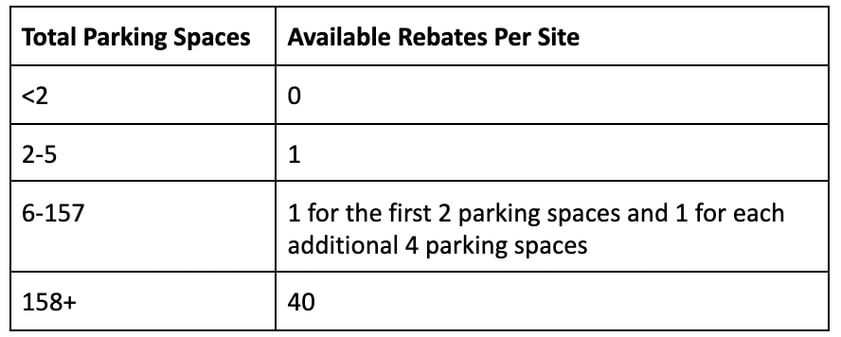How to Access LADWP’s Commercial EV Charging Station Rebate Program

Throughout 2021, the Los Angeles City Council has been developing a city-wide infrastructure and clean energy policy based on the LA100 Study, which aims to transition the city to 100% renewable energy generation by 2045 at latest, 2035 at soonest. Part of that policy is an electric vehicle (EV) master plan to push the city towards faster mass adoption of EVs.
An integral part of promoting EV adoption across LA is placing the right EV charging infrastructure across the city, especially in disadvantaged communities. On this front, the LA Department of Power and Water (LADWP)—the nation’s largest municipal utility—has begun granting commercial companies rebates to install EV Supply Equipment (EVSE) at their buildings through their Commercial EV Charging Station Rebate Program.
Rebate amounts differ for Level 2 and Level 3 chargers, as well as for light-, medium- and heavy-duty EVSE. But in all cases, rebates can be substantial enough to cover almost the entire cost of installing a new EVSE. Read on to learn how you can capitalize on available funding.
How Does LADWP’s Commercial EV Charging Station Rebate Program Work?
What Does the Program Pay For?
LADWP offers rebates up to a set amount depending on the type of EVSE you purchase. While rebates can’t exceed your out-of-pocket costs, they can be used to cover the purchase of the chargers themselves or installation costs. That includes the hardware and labor costs for “panels, circuit breakers and meter sockets, electrical conduits, wiring, junction boxes, disconnects, switches, and fuses, as well as the make-ready costs of trenching, resurfacing and connecting charging stations.”
The Charge Ready Program also offers participants post-installation rebates on the purchase and installation costs of EVSE. And the program can be stacked with other incentives and subsidies—especially the CALeVIP program—to pay for the remaining purchase and installation costs.
While LADWP might require commercial customers in the charger rebate program to pay a security deposit for transformer upgrades which isn’t eligible for a rebate, any costs related to transformer upgrades beyond the security deposit are eligible.
How Many Charging Stations Can I Install?
Your maximum rebate amount depends on where your site is located, what level chargers you’re installing, and whether they’re being used for light-duty EVs. Use this table to help estimate how much you could get back on your EVSE purchase:

The number of installed charging stations you can get rebated depends on the total parking spaces you have available. For Level 2 chargers, LADWP uses this formula:

For Level 3 (i.e., DC Fast Chargers) stations, you can receive up to 4 rebates per site. If access to your chargers is restricted (e.g., limited to building residents or clientele), you can receive up to 2 rebates.
How Do I Get My Rebates?
Before beginning work, you must submit plans for your EVSE deployment to LADWP to be reimbursed. Plans are submitted through LADWP’s Commercial EV Charging Station Customer Submittal Package. LADWP allocates its funding in cycles. In between each cycle applications aren’t accepted. Check LADWP’s Commercial EV dashboard for up-to-date information on whether applications are currently being accepted.
After LADWP approves your plans, you can commence with the make-ready infrastructure if necessary, as well as the purchase and installation of EVSE. LADWP will coordinate any make-ready infrastructure on the utility side of the meter.
After you’ve finished installing new EVSE, you’ll apply for a rebate by submitting a Commercial EV Charging Station Rebate Program Application. You’ll receive your rebate within 12 months of LADWP receiving all required documentation.
Let Enel X help you navigate the rebate application and fast track the EVSE selection process.
What are the Eligibility Requirements for LADWP’s Commercial EV Charging Station Rebate Program?
LADWP only requires rebate applicants to meet two criteria: receive electric service from LADWP on a non-residential rate schedule, and keep your charging equipment operational for at least two years.
LADWP has a longer list of requirements for the EVSE you purchase. They must be:
1. Certified and listed by a nationally recognized testing laboratory
2. Purchased new and unused
3. Purchased and installed on or after January 1, 2019
4. Permanently installed by a licensed electrical contractor
5. Accessible to LADWP employees, LADWP customer, residents, visitors or tenants
6. Used to charge on-road plug-in battery EVs or plug-in hybrid EVs
Level 2 chargers must have a J17772 connector, with an output power of at least 6.6 kW, and DC fast chargers must have an output of at least 50kW (24kW or more for medium- and heavy-duty EVS) and at least two of these three connector types: CHAdeMO, SAE CCS, and/or Tesla.
The Business Case for Installing Smart Chargers at Your Site
LADWP’s Commercial EV Charging Station Rebate Program offers different rebate amounts for Level 2 and DC Fast Chargers (DCFCs), which reflect their relative purchase and installation costs. In either case, rebate amounts could cover nearly the full purchase and installation cost. Given that, how do you choose which is right for your site?
The first thing to consider is the purpose each charger type serves. Level 2 chargers like Enel X’s JuiceBox Pro use dedicated 240V outlets to recharge up to 45 miles of driving range per hour of charging. They are best used by drivers who plan to spend more than an hour inside a location—tenants, employees—or only need a small recharge to get to their next charge point.
DCFCs like Enel X’s JuicePump 50 kW use direct current (DC) as opposed to alternating current (AC) to charge anywhere from 8-16 times faster than Level 2 chargers. They target drivers who need to replenish a lot of battery capacity quickly, and are willing to pay a bit more for it. That could mean drivers on road trips or those who don’t have charger access at work or home.
The Smart Charging Difference
Whether you’re installing Level 2 chargers or DCFCs, choosing a smart charger is the only way to capture the true value of EVSE at your site. Only smart chargers have load balancing features that give commercial owners control over when and how energy gets used at their charging stations. Smart chargers like Enel X’s JuiceBox Pro use these features to pull less electricity overall while helping owners avoid costly demand spikes.
Smart chargers also give you and EV drivers charging at your stations unparalleled transparency into the process. Enel X’s JuiceNet app, for instance, shows you both real-time and aggregate views of energy data to help simplify sustainability and compliance reporting while clarifying budget forecasting.
Taken together, the benefits of smart charging help serve your business in three key ways:
Future-Proofing
As Los Angeles residents trade out their gas-powered cars for electric ones, charger access will become a factor in where they choose to live, shop, exercise, relax and work. Map technology will help drivers find available chargers with matching connectors along their route, and the owners of those chargers will gain a competitive advantage over their peers—both in unlocking a new passive revenue stream and in attracting clientele.
Revenue Generation
In the first two quarters of 2021, EV sales in LA County alone accounted for 27% of California’s EV sales, putting nearly 33,000 new EVs on the LA county’s roads. Their drivers need convenient, reliable charging, and smart EV chargers provide that while putting more control and flexibility in EVSE owners’ hands. Smart charging IoT platforms like Enel X’s JuiceNet app let EV owners track charging progress while they’re away from their vehicle, and specify charging limits to manage their costs and energy savings. Meanwhile, they enable EV charger owners to participate in vehicle-to-grid demand response events, earning money by sending the grid electricity from plugged-in EVs during moments of peak supply chain strain.
Building Regulation Compliance
LA’s new building codes will largely be subject to the statewide CALGreen Building Code, which stands to be updated in 2022. Lawmakers in Sacramento are advocating it to require multifamily buildings across the state to significantly increase the percentage of parking spaces with EV chargers. For non-residential buildings as well, CALGreen currently mandates that 6% of parking spaces in all new buildings with 10 or more parking spaces must have EV Capable infrastructure. Compare these figures to LA’s EV goals over the next fifteen years, and it’s clear that EVSE mandates in commercial buildings are only going to rise.
Case Study: How Classic Parking Used LADWP’s Rebate Program to Save $200,000 on Smart EV Charging Stations
Classic Parking, Inc. is an operator of parking facilities for premier entertainment destinations like the Rose Bowl Stadium, STAPLES Centre, Greek Theatre, and Shrine Auditorium. The Shrine Auditorium parking facility serves an average of 400 vehicles per day and up to 1,000 cars during major events.
Through LADWP’s Commercial EV Charging Station Rebate Program, David Gardner, CEO of Classic Parking, saw an opportunity to meet the rising demand for EV charging at Shrine Auditorium at no cost to the business. “We realized we could drive additional traffic to the parking lot and save hundreds of thousands of dollars on an investment we were already planning to make in the future—it wasn’t even a 5-minute decision,” said Garner.
Classic Parking engaged EV charging station installer Green Water and Power, which chose Enel X’s JuiceBox Pro smart EV charging stations for all 40 grid-connected chargers, all of which are controlled by Enel X’s JuiceNet Enterprise smart charging platform.
“There is no better time than now to invest in future-proofing your property with EV charging while you can use incentives to install charging equipment at low or zero cost,” said Danny Gold, President And Founder, Green Water And Power. “The ability to leverage the LADWP incentive helped make this EV charging project a great investment for Classic Parking, and Enel X’s JuiceBox charging stations were the perfect technology fit.”
With JuiceBox chargers in place, and data flowing to the JuiceNet App, Classic Parking is:
- Attracting a new LADWP customer by advertising the charging stations on public EV charging station maps
- increasing occupancy of the parking facility by drawing EV-driving monthly renters from USC and other nearby businesses
- generating new revenue by charging EV drivers to use EV charging equipment
- building the Classic Parking brand by offering a cutting-edge and useful new amenity
Enel X has helped thousands of business customers like Classic Parking get the most out of their EVSE while reducing costs through utility incentives. With Level 2 and 3 smart chargers available and local expertise across LADWP’s territory, we can help you move through the application process, maximize your rebates, and select the EVSE that best suits your business needs.






